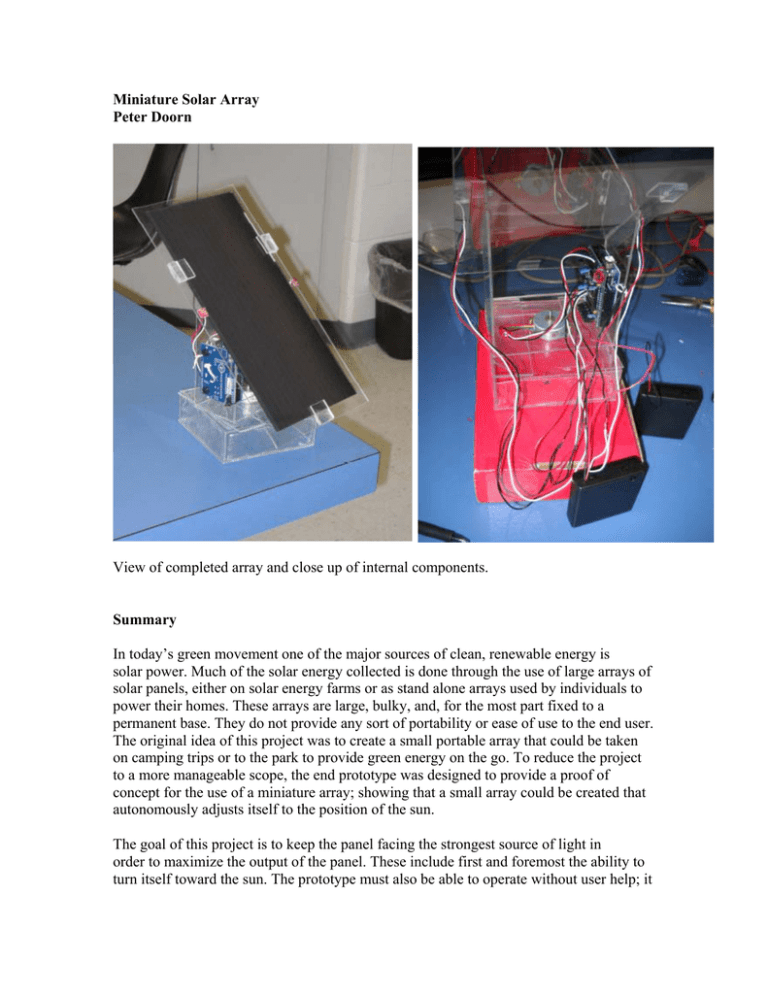Miniature Solar Array Peter Doorn Summary
advertisement

Miniature Solar Array Peter Doorn View of completed array and close up of internal components. Summary In today’s green movement one of the major sources of clean, renewable energy is solar power. Much of the solar energy collected is done through the use of large arrays of solar panels, either on solar energy farms or as stand alone arrays used by individuals to power their homes. These arrays are large, bulky, and, for the most part fixed to a permanent base. They do not provide any sort of portability or ease of use to the end user. The original idea of this project was to create a small portable array that could be taken on camping trips or to the park to provide green energy on the go. To reduce the project to a more manageable scope, the end prototype was designed to provide a proof of concept for the use of a miniature array; showing that a small array could be created that autonomously adjusts itself to the position of the sun. The goal of this project is to keep the panel facing the strongest source of light in order to maximize the output of the panel. These include first and foremost the ability to turn itself toward the sun. The prototype must also be able to operate without user help; it must be able to be turned on and left to perform its tasks. It needs to be sufficiently stable and durable while still weighing as little as possible. Keeping the weight down increases the portability of the unit. Finally, the sensors used must be capable of sufficient sensitivity to allow for accurate and correct readings of the amount light reaching the panel. In order to meet these requirements several concepts were considered. The favorite concept among the original set had the panel being mounted on top of a simple tripod. This concept allowed for two axes of rotation for the panel and for the panel and motor assembly to be easily removed from the tripod so that it could be collapsed and carried easily. Other concepts included using a tilting table that could be operated along two axes using motors and featured collapsible legs to improve portability. A third considered concept was a simple one axis swinging array that had almost no portability at all. The forth concept used extendable struts to raise and lower each corner of the panel so that it could face the sun. This concept also had very little portability. Each of these concepts were designed to make use of either a microcontroller or a custom made logic circuit to read the light sensors and move the panel accordingly. The final design for the prototype ended up being a mix of the first and third concepts. The final design included the forth concepts one axis of rotation, east-west, on a simple base but made use of the first concept’s movement mechanism and has a similar support structure for the panel. The main structure of the final design is made of acrylic panels and uses a single unipolar stepper motor to achieve movement. The ambient light sensors used are sensitive to the full visible spectrum and the information from these sensors is processed and used to operate the motor using an Arduino Duemilanove microcontroller with a motor shield. It is also designed to use both the panel and backup batteries to power the system. The final prototype is capable of 360 degree rotation and operates without human interference other than the initial turning on of the system. The movement it not as smooth, precise, or complete as desired but it is acceptable for the prototype. The overall structure is slightly top heavy but is otherwise stable and the frame is fairly durable. The response from the panel is not as expected and the system relies on the batteries or other DC source as the primary source of power.




